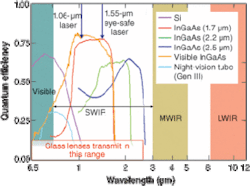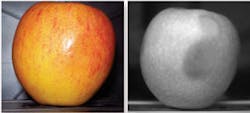IR IMAGING: Short-wave IR offers unique remote sensing solutions
MARTIN ETTENBERG AND DOUGLAS MALCHOW
The shortwave infrared (SWIR) wavelength band is rich in potential for solving imaging challenges in measurement, inspection, and process-monitoring tasks. Spectral signatures in the SWIR can reveal the presence of contaminants or moisture in agricultural products. Hot-furnace processes and walls can be inspected through ordinary safety glass enclosures or with off-the-shelf glass lenses or optics. Glass manufacturers can image in the SWIR at high speed, monitoring the cooling process to identify costly defects inside bottles before waste costs balloon.
The SWIR, sometimes called the near-infrared (NIR) band, is generally defined as falling between 0.7 and 2.5 µm. The region starts where the human eye response falls off (beyond deep red) and extends to the longer wavelengths at which glass absorbs rather than transmits light. The SWIR region is distinguished from the mid-wave infrared (MWIR) at 3- to 5-µm and the long-wave infrared (LWIR) over the 7- to 14-µm waveband regions at boundaries marked by strong atmospheric absorption bands (see Fig. 1).
In NIR spectroscopy applications, the SWIR band is important for remote identification of materials and gases because of absorption of light at wavelengths that match the harmonic frequencies of unique molecular-bond vibrations. Water has strong absorbance at several key wavelengths in the SWIR, for instance, allowing users to detect and quantify the relative dryness of agricultural and textile products. Moisture uniformity and density in a product can be mapped by imaging light transmitted through or reflected from an object at specific wavelengths at which water absorption is highest. The image of interest is compared against a reference image taken of a similar object with known moisture content (see Fig. 2).Uniformity monitoring
Key to NIR spectroscopy applications is controlling the intensity and wavelength of the light source and the wavelengths detected. Light sources abound in this region, with incandescent light bulbs and LEDs readily available. Light bulbs provide a broadband continuum of energy over the entire SWIR range, with peak output at approximately 1 μm for tungsten filament bulbs. This is especially useful for chemical identification, using a spectrometer in front of array detectors for simultaneous detection at multiple wavelengths. Multiple bulbs permit high light levels, allowing the use of small lens apertures to obtain sharp focus over a wide depth-of-field, while also providing diffuse illumination of the object.
System designers must avoid overheating the sample materials when using incandescent bulbs. An alternative is solid-state LEDs, which are now available over a spectral range that covers most SWIR wavelengths, including key wavelengths for hydroxide, H2O, and methane. The cooler operating temperature and smaller size of LEDs allows placement of the source closer to the object being imaged. LEDs also provide diffuse and even illumination and enable rapid switching between key wavelengths. This is valuable for looking at the difference or ratio of images taken at two wavelengths, which enables the mapping of moisture uniformity while ignoring surface variations. Switching times for LEDs are fast enough to be cycled on a frame-by-frame basis. When objects are moving fast enough to change position on that time scale, image-processing software can compensate for the movement before producing the uniformity map.
An additional benefit of the availability of LEDs over a wide spectral range is the ability to simultaneously image an object with visible and SWIR cameras without one interfering with the other (see Fig. 3). For example, color inspection of labeling could be performed with white LEDs while the product fill level inside an opaque bottle and product spillage on the label is detected with the SWIR camera using 1.45-µm LED illumination (for the best contrast of water-based products).Another multispectral method for spectral identification of moving objects requires multiple cameras using broadband illumination with bandpass filters on each camera. Once the cameras are optically aligned, images are acquired simultaneously, eliminating the image processing mentioned previously. When more-robust spectral identification is needed to detect many types of contaminants, hyperspectral imaging captures the complete spectra at each image location, creating a 3-D hyperspectral cube of data. This is accomplished for moving objects by using 2-D (area) cameras with an imaging spectrometer, in which the camera captures spectra on one axis at many positions across the other axis. Motion of the object past the slit position provides the third dimension. For objects that are momentarily stationary or slow moving, a mechanical filter wheel or an electronically tunable filter mounted in front of the camera can also be used to take images at multiple wavelengths.
InGaAs detector advantages
High-quality indium gallium arsenide (InGaAs)-based SWIR cameras are solid-state and operate with their focal planes stabilized at room temperature. The uniformity and stability of the material over time allows for factory-installed nonuniformity corrections (NUCs), thus eliminating the need for mechanical shutters or coolers with their limited lifetime and high power consumption. Alternative detector and sensing technologies in this wavelength band are more expensive and less reliable because of their need for cryogenic operating temperatures. Cooling the array allows improved performance from the detector but it requires a costlier, larger, and more power-hungry system to accommodate the cooling process. It is very difficult to produce a low-dark-current InGaAs at room temperature with less than 0.5% bad pixels (typical), making it critical to choose the InGaAs-detector vendor carefully to achieve the best possible results for the lowest total cost.
Linear- vs. area-array cameras
For machine-vision applications, system integrators have a choice of 1-D linear-array or 2-D area-array cameras. When products or processes are moving continuously, square-pixel linear-array SWIR cameras, also known as linescan cameras, provide image widths of up to 1024 pixels at more than 4200 lines per second (lps) or 512 pixels at over 19,000 lps. These cameras are considerably less expensive than area cameras, while providing wider field of view. Single, InGaAs-based SWIR cameras are being used to monitor hot-glass processes, scanning semiconductor wafers through the back-side, and checking for fill level or product spillage. Multiple cameras with bandpass filters are used for mapping uniformity of a substance or coating.
Linear-array cameras with slit-shaped pixels are being used to make spot measurements with complete spectra via a single fiberoptic into a flat-field spectrometer. To sample a complete conveyor-belt width, multiple fiberoptic probes are multiplexed into the same type of spectrometer. When high resolution across the belt width is needed, an imaging spectrometer fitted with an area-array camera is used to image unique spectra for each location across the belt, creating a 3-D hyperspectral cube of information. For the most demanding applications, such as imaging a slowly changing scene, a 4-D cube can be captured by using an electronically tunable wavelength filter in front of a 2-D camera, to record x, y, wavelength, and time.
Free-space communication
High-frame-rate SWIR windowing cameras are frequently used to locate and track free-space-communications laser beams at 1.55 µm, providing active feedback to telescope mirrors to keep the beam centered on high-speed detectors. Cameras that provide 320 × 256-pixel images can be as small as a 9-V battery and fit into small available spaces, delivering 16 × 16 regions of interest (ROI) at more than 10,000 frames per second (fps). Larger cameras, with 640 × 512-pixel image size (full frames 30 fps) and high-frame-rate ROI are being used in adaptive optics systems to correct imaging systems for atmosphere turbulence.
Hot-process monitoring
The SWIR band is also used for detecting the emission of hot objects, typically those at 100°C or more. Valuable for inspection of hot glass processes, InGaAs-based cameras see inside glass bottles to find defects and can simultaneously monitor the temperature uniformity during the cool-down process. Typical thermal cameras (LWIR/MWIR) cannot see inside the glass bottle being inspected so the imagery they provide is only of the outside surface. The SWIR inspection of furnaces or hot metals processing is ideal with InGaAs cameras because they can easily image through the standard safety glass or quartz window enclosures used to protect the cameras. The use of imagers that require exotic lens or window materials is cost prohibitive, especially when the hot process involves liquid splatter that often necessitates periodic replacement of the safety window.
Another SWIR imaging application is in monitoring hot processes for the recovery of chemicals. Solid-state InGaAs cameras, with their high-resolution, low lag, long lifetime, and superior signal-to-noise ratios, are now replacing previously used tube technology.
Although mid-wave and long-wave infrared cameras are also used to monitor hot processes, they are limited by the glass cutoff and the expense of image size and high frame rates. Uncooled microbolometer cameras have lower costs but are confined to video field rates (30 fps with a 640 × 512-pixel size and no high-speed windowing), while high-frame-rate cryogenically cooled indium antimonide (InSb) or mercury cadmium telluride (HgCdTe) cameras with windowing capability are 50% to 100% more expensive than comparable-size InGaAs cameras. Expense is not just confined to purchase costs-the cooled MWIR and LWIR cameras are costly in space, power, and servicing requirements, compared to all-solid-state InGaAs cameras.


